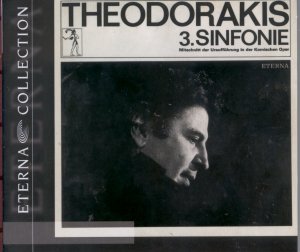The Greek composer Mikis Theodorakis was born in 1925.
He wrote with an allegiance to the folk culture of his country - a culture
that had been long suppressed and diluted by the dominant Turkish voice.
During the Second World War he joined the resistance against the occupying
German and Italian troops. His anger can be heard in the finale of the
Third Symphony. His First Symphony dates from 1948 written after learning
of the death of his boyhood friend Lt. Makis Karlis. Apparently the
First is purely orchestral and is threaded through with Greek tragedies,
wall-paintings and the influence of Shostakovich's Leningrad Symphony.
The Second and Third use poetic texts. The Second is called The Song
of the Earth.
The Third is based on verse by Dionysius Solomos (1798-1837).
This is an ambitiously scaled choral symphony. It begins with modest
self control with a mezza voce chant-like theme carried by the strings
and then joined by the voices. The music proceeds reverently and in
peace with gong-stroke punctuation. Jangling restlessness then gains
ascendancy with, not for the last time, rock-style activity from the
percussion. Everything is tonal and accessible - very approachable music
with sincere spiritual depth. At the zenith of the first movement the
music has the weighty deliberation of Beethoven, the ecstasy of Howells
(in the surging writing for soloist and choir - Stabat Mater and
Missa Sabrinensis) and the massive choral impact of Stravinsky's
Oedipus Rex and Klami's Hymnus (Finlandia FACD369). The
second movement goes at a scathing hunting pace - a brusque and aggressive
chase. This movement points up Theodorakis's skill with repetition of
melodic and rhythmic material. This is more angular writing than that
found in the first movement. Solo instruments dart and fly out of the
textures with braying and ululating work for the brass like Hans Werner
Henze's The Wreck of the Medusa. In fact the violent variety
of the Henze work makes for quite a good parallel - at least for the
second movement. After the frenetic turmoil of the Presto (tr.
2) the strings-led consolation of the Adagio offers balm and
pathos. This is written to bring out the sonority of a grand string
section but rises to a smashingly bumptious and incongruous orchestral
peak after which the choir sing out with all the fervour of a Latvian
patriotic hymn. The finale passes through Allegro vivace, Presto,
Largo and Andante episodes. Almost as long as the first
movement its incessant onward tumult finally stops and we sink into
a Largo for strings over which a fragile high trumpet solo wheels as
does the mollifying voice of Els Bolkestein. The work ends with a slowly
graceful rising hymn for high strings and full choir falling into a
chilly desolation amid the choir's sprechgesang whisperings. This work
reminded me at several levels of Benjamin Leesí Fourth Symphony Memorial
Candles (Naxos 8.559002) and Holmboe's Nietzsche Requiem (Dacapo
8.224207).
The useful notes are by Albrecht Duemling. The text
are not given. The singing is in Greek.
Rob Barnett

